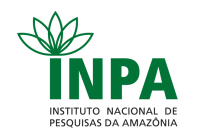Corpo Discente - Egressos
Francisca da Silva Ferreira
| Título | BIOSSURFACTANTES DE FUNGOS ENDOFÍTICOS ISOLADOS DE Gustavia cf. hexapetala (Alb.) Sm. (Lecythidaceae) NA AMAZÔNIA, CONTRA PATÓGENOS DA CAVIDADE ORAL | ||||||||||||||||||||||||
| Data da Defesa | 13/02/2020 | ||||||||||||||||||||||||
| Download | Em sigilo | ||||||||||||||||||||||||
Banca
| |||||||||||||||||||||||||
| Palavras-Chaves | bioativos, fungos endofíticos, microbiota oral, planta medicinal, Amazônia | ||||||||||||||||||||||||
| Resumo | Os biossurfactantes (BS) são moléculas anfifílicas que por suas características químicas têm apresentado grande interesse industrial. Há evidências de aplicação na área odontológica por apresentarem ação antimicrobiana contra patógenos de interesse. Nesse aspecto o presente estudo avaliou a produção de BS em linhagens de fungos endofíticos isolados de Gustavia cf. hexapetala, na cidade de Manaus, com ação antimicrobiana contra patógenos da cavidade oral. Foi realizado isolamento de fungos endofíticos de galhos e folhas, purificação, conservação e caracterização morfológica dos isolados. Realizou-se uma triagem para selecionar fungos produtores de BS cultivados em meio líquido (BDL e mineral) suplementados com óleo de soja. As condições de cultivo foram: pH 7.0, temperatura de 28°C à 170rpm, por 10 dias. A produção de BS foi avaliada por meio do índice de emulsificação (E24) e da Tensão Superficial (TS) do meio de cultivo. Foi realizado um novo cultivo em escala ampliada para a extração dos BS. Com os BS brutos foi possível determinar a CMC, testes antimicrobianos e perfil químico. Os fungos selecionados foram identificados por meio de técnicas moleculares. Foram isolados 399 fungos e uma levedura negra de G. Cf. hexapétala. A frequência de isolamento foi 74,6% a partir de galhos e 49,6% a partir da folha. Reagrupou-se em 20 morfogrupos com oito gêneros identificados: Colletotrichum, Fusarium, Pestalotiopsis, Penicillium, Guigniardia, Phomopsis, Xylaria, Diaphorte e os demais desconhecidos (Micelia sterilia). Foram conservados 187 fungos endofíticos,, avaliados 24 e destes, nove se destacaram como produtores de BS, sendo cinco selecionados, tais quais: três isolados de galho identificados como Fusarium decemcellulare (FF17), Diaporthe sp. (FF36) e Fusarium solani (FF45); dois isolados de folha, identificados como Fusarium solani (FF51) ) e Coletotrichum vietnamensi (FF33). Os melhores resultados do E24 foram: C. vietnamensi (FF33) com 33,99%, Diaporthe sp. (FF36) com 31,97%, e F. solani (FF51) com 26,70%. Houve redução da TS abaixo de 35,0 mN/m em 09 cepas com destaque para F. solani (FF51) com 28,7 e 30,1 mN/m; F. solani (FF45) com 31,5 e 30,1 mN/m; C. vietnamensi (FF33) com 32,4 e 31,8 mN/m; Diaporthe sp. (FF36) com 32,7 e 30,9 mN/m cultivados em meio BDL e mineral respectivamente. A TS do meio mineral reduziu de 61,0 mN/m para 30,9 mN/m (49,3% de redução) para o fungo Diaporthe sp. (FF36), e para os fungos F. solani (FF45 e FF51) com 30,1 mN/m (50,6% de redução). O maior rendimento da produção de BS foi de 0,66 g/L, obtido com o extrato do fungo C. vietnamensi (FF33). Este endofófito produziu um BS com a menor CMC (1,08 mg/mL) reduzindo a TS da água ultrapura de 70,6 para 31,94 mN/m (54,8% de redução). Nos testes antimicrobianos a CIM do extrato de F. decemcellulare (FF17) contra Streptococcus mutans (ATCC25175) foi de 0,4 mg/mL e a CBM foi 0,5 mg/mL; para Lactobacillus casei (ATCC7469), a CIM foi 1,5 mg/mL, e a CBM foi 1,75 mg/mL. Os bioativos produzidos por Diaporthe sp. (FF36) apresentaram CIM de 2,4 mg/mL contra S. mutans. A CIM do extrato de micélio de F. solani (FF51) para o L. casei foi 1,8 mg/mL. O extrato de micélio de F. solani (FF45) apresentou ação bacteriostática para L. casei e fungistática para C. albicans (CIM de 2,1 mg/mL e 4,2 mg/mL, respectivamente). Os resultados indicam a importância de pesquisas que visam a prospecção de fungos endofíticos com potencial para a produção de BS e outros bioativos de interesse biotecnológicos, contra patógenos da cavidade oral, permitindo inserir o uso de moléculas naturais para o controle de doenças bucais. | ||||||||||||||||||||||||
| Abstract | Biosurfactants (BS) are amphiphilic molecules which, due to their chemical characteristics, have been of great industrial interest. There is evidence of application in dentistry due to their antimicrobial action against pathogens of interest. Thus, this study evaluated the production of BS in strains of endophytic fungi isolated from Gustavia cf. hexapetala, in the city of Manaus, with antimicrobial action against pathogens in the oral cavity. The isolation of endophytic fungi from branches and leaves, purification, conservation and morphological characterization of the isolates were carried out. Screening was performed to select BS-producing fungi grown in liquid (BDL and mineral) supplemented with soybean oil. The culture conditions were: pH 7.0, temperature of 28 °C at 170 rpm, for 10 days. BS production was evaluated using the emulsification index (E24) and the Surface Tension (ST) of the culture medium. A new culture was made on an expanded scale for the extraction of BS. With the raw BS, it was possible to determine the CMC, antimicrobial tests and chemical profile. The selected fungi were identified using molecular techniques. Three hundred ninety-nine (399) fungi and a black yeast of G. cf. hexapétala were isolated. The isolation frequency was 74.6% from branches and 49.6% from leaves. They were grouped into 20 morphogroups with eight identified genera: Colletotrichum, Fusarium, Pestalotiopsis, Penicillium, Guigniardia, Phomopsis, Xylaria, Diaphorte and the others, unknown (Micelia sterilia). One hundred eighty-seven (187) endophytic fungi were conserved, of which 24 were evaluated, and of these, nine stood out as BS producers, and five were selected: three branch isolates were identified as Fusarium decemcellulare (FF17), Diaporthe sp. (FF36) and Fusarium solani (FF45); two leaf isolates were identified as Fusarium solani (FF51) and Coletotrichum vietnamensi (FF33). The best E24 results were: C. vietnamensi (FF33) with 33.99%, Diaporthe sp. (FF36) with 31.97%, and F. solani (FF51) with 26.70%. There was ST reduction below 35.0 mN/m in 09 strains, with emphasis on F. solani (FF51) with 28.7 and 30.1 mN/m; F. solani (FF45) with 31.5 and 30.1 mN / m; C. vietnamensi (FF33) with 32.4 and 31.8 mN/m; Diaporthe sp. (FF36) with 32.7 and 30.9 mN/m grown in BDL and mineral medium, respectively. The ST of the mineral medium decreased from 61.0 mN/m to 30.9 mN/m (49.3% reduction) for fungus Diaporthe sp. (FF36), and for fungi F. solani (FF45 and FF51) with 30.1 mN/m (50.6% reduction). The highest yield of BS production was 0.66 g/L, obtained from the extract of fungus C. vietnamensi (FF33). This endophyte produced a BS with the lowest CMC (1.08 mg/mL) reducing the ST of ultrapure water from 70.6 to 31.94 mN/m (54.8% reduction). In the antimicrobial tests, the MIC of F. decemcellulare (FF17) extract against Streptococcus mutans (ATCC25175) was 0.4 mg/mL and the MBC was 0.5 mg/mL; for Lactobacillus casei (ATCC7469), the MIC was 1.5 mg/ml, and the MBC was 1.75 mg/ml. The bioactives produced by Diaporthe sp. (FF36) showed an MIC of 2.4 mg/mL against S. mutans. The MIC of F. solani mycelium extract (FF51) for L. casei was 1.8 mg/mL. The mycelium extract of F. solani (FF45) showed bacteriostatic action for L. casei and fungistatic for C. albicans (MIC of 2.1 mg/mL and 4.2 mg/mL, respectively). The results indicate the importance of research aimed at the prospection of endophytic fungi with a potential to produce BS and other bioactives of biotechnological interest, against pathogens in the oral cavity, allowing the use of natural molecules to control oral diseases. | ||||||||||||||||||||||||
Parceiros

























